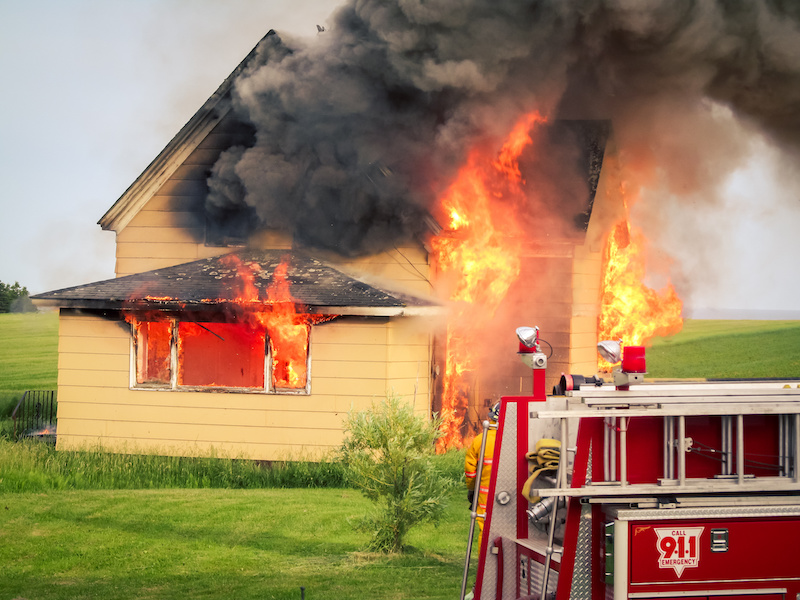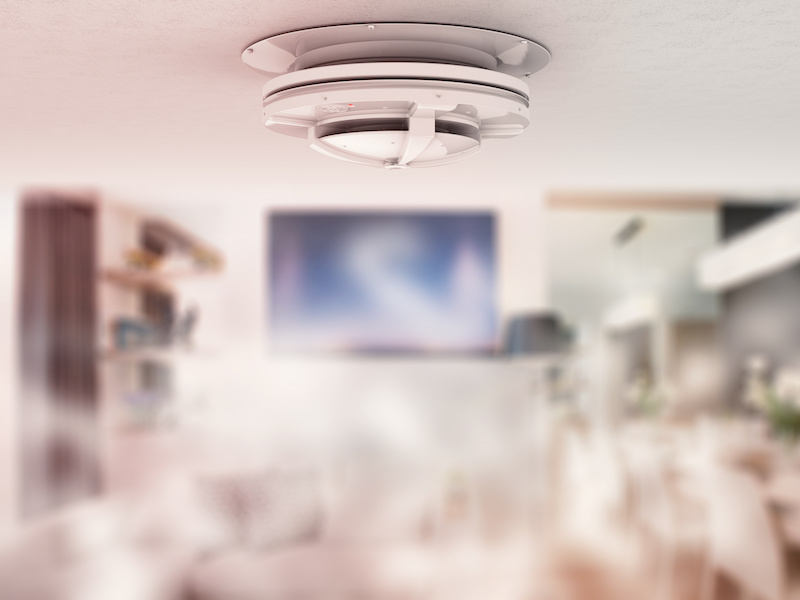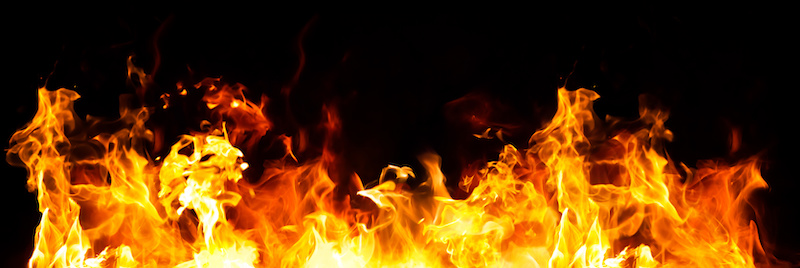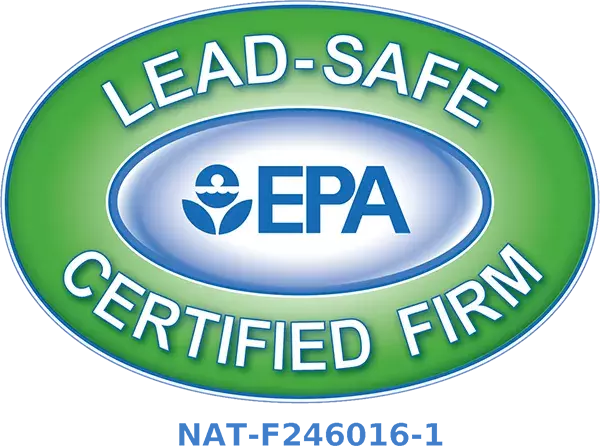Ever lit a match and watched as the flame danced, flickered, and then slowly consumed the stick? That’s fire in action – captivating but dangerous. The science of it all might not cross your mind when you’re roasting marshmallows over an open campfire or lighting candles on a birthday cake. But what if we dug deeper?
Fire is no magic trick; there’s an entire world of scientific principles at play here. Ever wondered why some materials burn while others don’t? Or how heat transfer helps a small spark turn into a raging inferno? How about the ways to stop fires before they wreak havoc?
This journey will lead us through residential blazes’ common causes, understanding fire classes and their extinguishing methods, right down to crafting evacuation plans for emergencies.
We’re diving into a story that’s not just intriguing, but also holds the potential to save lives. Let’s get started!
Table Of Contents:
- The Science Behind Fire Ignition
- Common Causes of Residential Fires
- The Role of Heat Transfer in Fire Propagation
- Fire Safety Measures in Homes
- Impact of Material Properties on Fire Behavior
- Understanding Fire Classes and Suitable Extinguishing Methods
- Importance of Evacuation Plans in Residential Fires
- The Impact of Fire on Human Health and Environment
- FAQs in Relation to the Science of Fire
- Conclusion
The Science Behind Fire Ignition
Fire, a powerful force of nature, follows simple scientific principles. To start a fire, three elements are essential: fuel, oxygen, and heat. This is known as the fire triangle.
Fuel can be anything that burns – wood in your fireplace or gas in your stove. Oxygen feeds the flames while heat gets things going.
To put it simply, think of starting a fire like baking cookies. Your dough (fuel) needs to reach an ignition temperature (heat), and you need air (oxygen) for the cookies to rise properly.
If any side of this ‘triangle’ is missing or removed, fires can’t ignite or they’ll fizzle out fast. It’s crucial knowledge when we talk about preventing residential fires.
- Fuel – Control what could potentially burn around your home.
- Oxygen – Regularly maintain HVAC systems.
- Heat – Stay vigilant with heating sources such as candles or stoves.
So remember: understanding how fire works isn’t just interesting science—it’s practical info that might save lives someday.
Common Causes of Residential Fires
The most frequent causes of home fires can often be traced back to everyday activities. NFPA reports that cooking is the main cause of residential fires.

Misuse of heating equipment also poses a significant risk. It’s like leaving your car running in a closed garage – not only dangerous but potentially fatal. Similarly, electrical issues, from faulty wiring to overloading circuits, are akin to playing with matches near gasoline.
Cigarettes may seem harmless when used responsibly (human health notwithstanding), but they’re among the top culprits for residential fires too – kind of like inviting a pyromaniac into your living room.
Lastly, we have candles; those innocent-looking fire-starters. As romantic and relaxing as they might be, left unattended or placed close to flammable materials you’ve got an indoor bonfire on your hands.
All these causes emphasize why it’s important to take safety precautions seriously – because even common household items can become potential hazards if misused or neglected. Let’s treat fire with respect rather than fear.
The Role of Heat Transfer in Fire Propagation
Heat transfer plays a crucial role in fire spread. This process involves three main methods: conduction, convection, and radiation.
Conduction
In much the same way that heat travels from one end of a metal rod to the other when you hold it over a flame, conduction works similarly during fires. It moves heat through solid materials directly touching each other.
Convection
Convection, on the other hand, transfers heat via fluids or gases – think hot air rising above cooler air.
Radiation
The third method is radiation. Much like sunlight warming your skin from afar, radiant energy can also ignite materials without needing direct contact or an intermediary fluid or gas.
- All these processes occur simultaneously and synergistically during a fire event.
- Understanding them is vital for effective fire prevention strategies.
- This knowledge helps inform better material selection and design choices around homes too.
Fire Safety Measures in Homes
Your home is your sanctuary, but it can quickly turn into a danger zone if proper fire safety measures aren’t implemented. Understanding and applying these steps can be the difference between minor damage and catastrophic loss.
The first line of defense is installing smoke alarms. They give early warning signs, buying precious time to evacuate or even extinguish smaller fires.

But prevention goes beyond alerts. Regularly inspecting electrical systems helps identify potential hazards before they spark disaster. Keep flammable materials away from heat sources – this simple step often gets overlooked yet it’s critical in preventing accidental fires.
Maintaining Fire Extinguishers
Having at least one fire extinguisher per floor could save your property, and more importantly, lives. But remember that they need regular checks to ensure their effectiveness when needed most.
A Safe Escape Plan
An evacuation plan isn’t just for schools or workplaces; every home needs one too. Practice drills with family members so everyone knows what to do during an emergency.
Impact of Material Properties on Fire Behavior
The type of material in a house can drastically change how fire behaves. Take wood, for instance. It’s a fuel-rich substance that burns quickly and fiercely, helping fires spread fast.
In contrast, metal objects don’t ignite easily but they conduct heat well, which could inadvertently help the fire grow by heating up surrounding areas (U.S Forest Service).
How Different Materials React to Fire
Fires feed off certain materials more than others due to their chemical makeup. For example, synthetic fabrics like polyester melt rather than burn because they’re made from petroleum products (National Institutes of Health).
This behavior not only intensifies the flames but also produces harmful gases that pose health risks.
Making Homes Safer Against Fires
- Selecting less combustible materials can make your home safer against fires.
- Fire-resistant doors and walls are also useful in slowing down fire spread within homes (NIST).
Understanding Fire Classes and Suitable Extinguishing Methods
Fires are classified based on what fuels them. This is important because the class of fire determines the most effective way to put it out.
Class A Fires
These fires involve ordinary combustibles like wood, paper, or cloth. Water extinguishers work best here due to their ability to cool the material below its ignition point.
Class B Fires
Fuelled by flammable liquids such as gasoline or oil, Class B fires need foam-based extinguishers that smother flames and prevent re-ignition.
Class C Fires
A Class C fire involves energized electrical equipment. It’s crucial not to use water but instead opt for a CO2 extinguisher which displaces oxygen around the fire.
D & K Class Fires:
- D-Class: The rarest home scenario involving metals like magnesium requires special powder extinguishers.
- K-Class: Specially designed for kitchen fires fueled by cooking oils and fats, they use wet chemical agents.
Importance of Evacuation Plans in Residential Fires
When flames break out in a residence, speed is of the essence. An evacuation plan can make the difference between safety and disaster. It’s not just about knowing how to escape; it’s also about understanding when and where fires are likely to start.
The U.S. Fire Administration stresses the importance of having two ways out from each room in your house. Doors may be blocked by flames or smoke making an alternative exit vital for survival.
Your evacuation strategy should also include designated meeting spots outside the house. This helps you quickly account for everyone and avoid needless re-entry into a burning building while trying to find someone who has already escaped safely.
Making Your Plan Effective
A good plan is one that everyone knows by heart. Practice makes perfect – especially with kids around. Frequent drills will ensure they know exactly what to do during an actual emergency.
Another crucial part of your strategy should involve the Red Cross’ advice on using alarms. Smoke detectors buy us precious time but need regular testing to stay effective.
In essence, planning ahead gives peace of mind because you’re prepared for something we all hope never happens – a residential fire.
The Impact of Fire on Human Health and Environment
Fire, a devastating power, creates chaos not just in homes but also in our health and the environment. When fire consumes everyday household materials like plastics or treated wood, it releases harmful pollutants into the air.
Studies show that these pollutants can cause respiratory issues and exacerbate existing conditions such as asthma. In more serious scenarios, breathing in smoke from a fire can cause permanent lung damage.
Beyond personal health impacts, fires contribute significantly to environmental degradation. Fire smoke contributes to environmental degradation by releasing CO2, a powerful greenhouse gas, into the atmosphere. This increases the global warming potential, which is an issue we are grappling with today.
In addition to CO2, fires generate particulate matter, which contaminates both air and water sources. Over time, this can disrupt ecosystems, causing harm to local flora and fauna.
A Case for Prevention: The California Wildfires
The California wildfires, fueled by rising temperatures due to climate change, serve as a stark reminder of how devastating unchecked fires can be for human health and our planet’s well-being.
This understanding underscores why prevention measures at home matter so much—they’re about safeguarding your family’s health while contributing positively towards environmental preservation too.
FAQs in Relation to the Science of Fire
What is the science of fire called?
The study of fires and their behavior is known as Fire Science.
What is the scientific study of fire?
The scientific examination of how fires start, spread, and can be controlled falls under Fire Science.
What does science say about fire?
Science explains that a mix of fuel, oxygen, and heat sparks a chemical reaction resulting in fire. This process is termed combustion.
What are the basics of fire science?
In basic terms, Fire Science involves understanding combustion processes, heat transfer methods, and materials’ flammability characteristics to manage or prevent fires effectively.
Conclusion
Fire’s beauty is as captivating as its science. But remember, it also packs a punch.
We’ve peeled back the layers of the science of fire, unmasking how heat transfer helps flames spread and devour homes. We’ve scrutinized common causes behind residential fires and laid bare prevention strategies.
Materials matter – some fan flames while others stifle them. Fire classes are no less important; knowing what to use for extinguishing can make all the difference.
An evacuation plan? Not just a good idea but vital! And let’s not forget about fires’ impact on health and the environment – another reason why prevention beats cure every time!
This knowledge isn’t merely interesting trivia; it could be life-saving information one day. So stay safe, folks!
If you are in need of fire damage restoration, contact us immediately at J&R Restoration. We can also help with water damage restoration, mold remediation, and interior remodeling.


